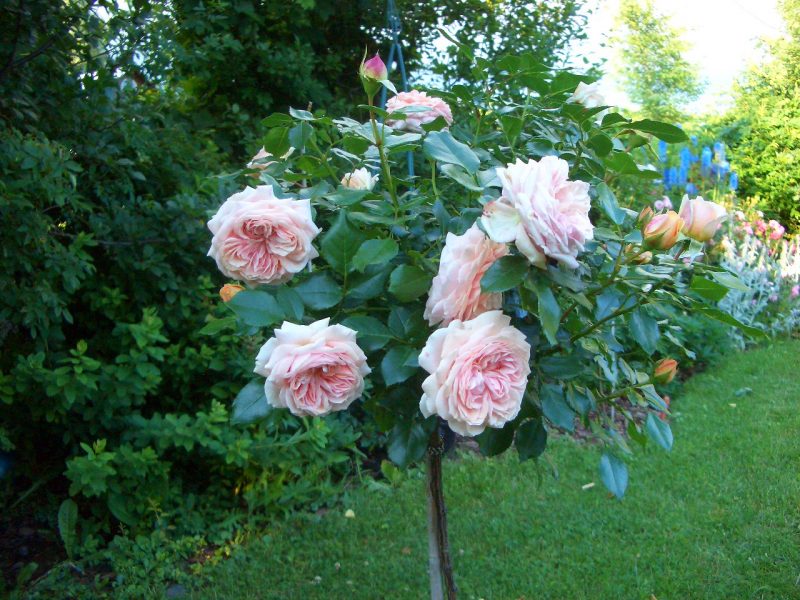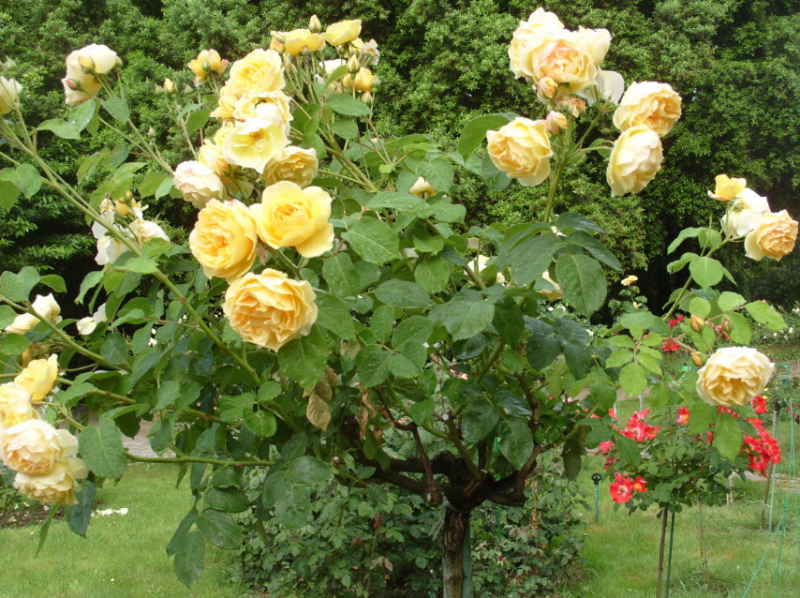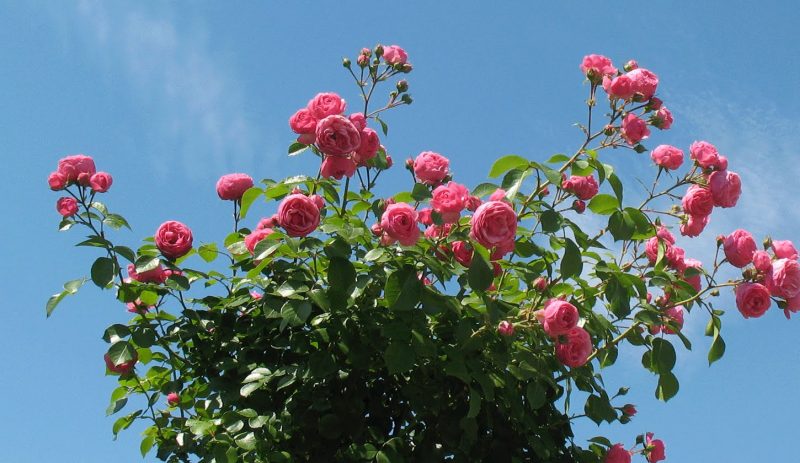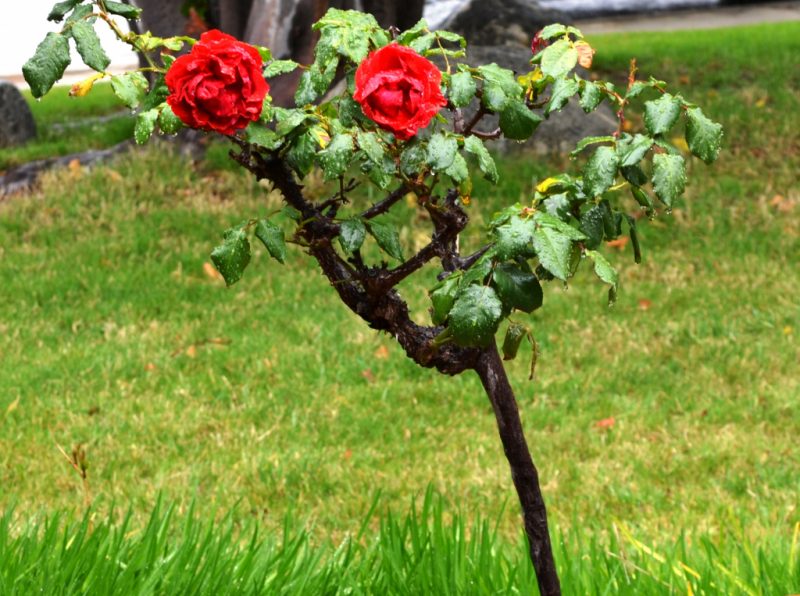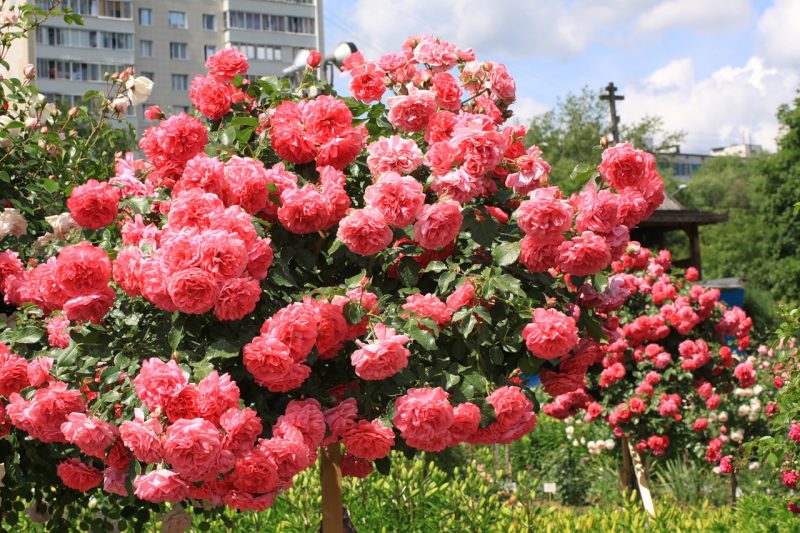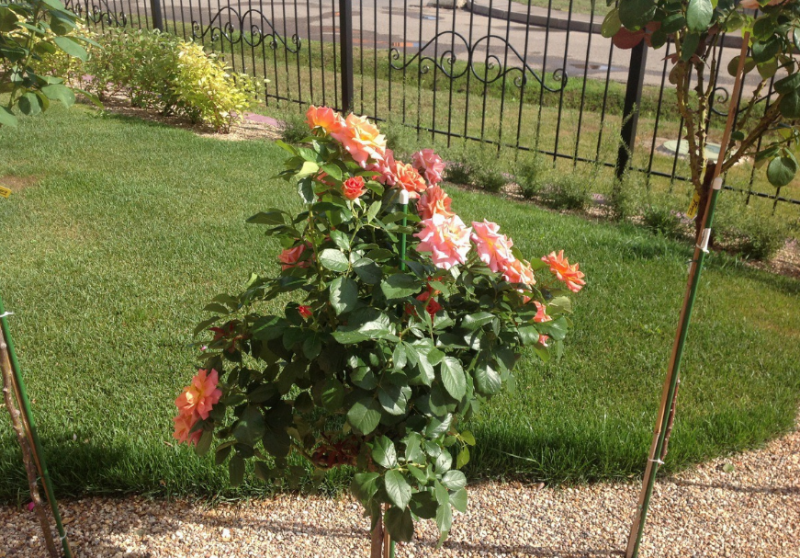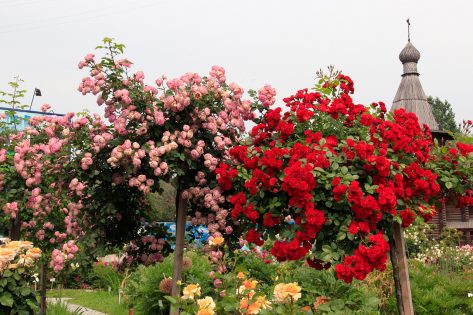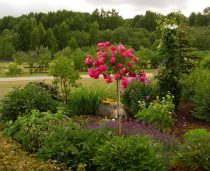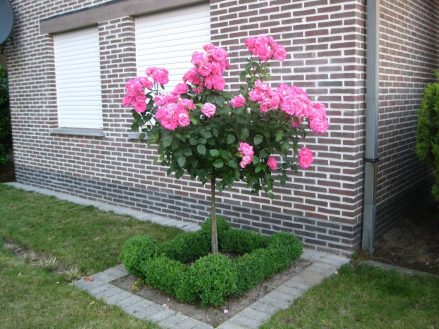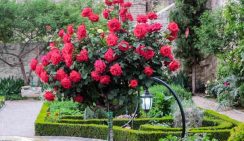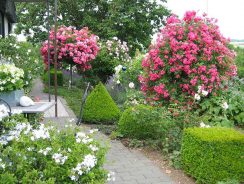The main decoration of any homestead will be a standard rose, which even a beginner grower can cope with growing it. Although the plant is a little picky, following the basic rules for caring for it, you can achieve long, plentiful and very colorful flowering.
Material Content:
Plant description
"Stamb" in German means "pillar". In a botanical language, this is part of the rose from the neck to the first shoots. Such roses can not be called bush - they are more like decorative trees. There are simply no such flowers in nature, because they are artificially grown by humans.
An interesting fact is that almost any kind of roses can be grown on a stem if desired. The main thing is a successful vaccination. Very often flower growers grow several varieties at the same time.
The following species are most often grown in the garden:
- miniature (plants with a height of up to 50 cm) - small strains are used for their cultivation, to which ground-cover species are grafted;
- half-stem (up to 80 cm) - Floribunda cultivar is used to grow such roses;
- standard (up to 110 cm) - inoculate tea-hybrid varieties;
- weeping (up to 170 cm) - several types of Rambler roses are grafted onto the trunk.
Popular varieties of standard roses
A number of forms and varieties suitable for growing as standard trees have been developed. The most favorite varieties among flower growers are Grose and Nozomi. If there is a desire to grow a weeping form, then the varieties “Ballerina” and also “Canary Bird” are excellent for such purposes.
Do not use heavy varieties of flowers, because if the top of the pink tree grows too thick, the rose will lose its decorative effect.
If the plot is small, then it is better to choose elegant varieties, such as Kniprs with miniature, pleasantly smelling and soft pink buds. The Immensi looks elegant. Very popular is the beautiful Catherine Deneuve, blooming with orange inflorescences.
For a beginner grower for growing pink trees, you can recommend the varieties "Princess de Monaco" and "Jardin de Bagatelle": they are quite unpretentious.
How to plant a plant on the site
The key to plentiful flowering is the proper planting of plants. It is advisable to plant roses in the spring, when steady heat comes. A great place for a standard tree is a calm area in the sun. If ground water lies close to the surface at the selected location, good drainage should be provided.
Landing pit should be prepared in advance - at least 2 weeks in advance. To do this, dig a hole about 70 cm in depth. The width of the pit depends on the root system of the seedling. If several plants are to be planted, then at least 1 meter should be left between the wells. To improve fertility at the bottom of the pit, you can add a little humus or at least rotted manure.
Usually a rosewood is grafted onto the rosehip root. In this case, when planting, the lower half of the vaccine is buried in the soil, and the upper part is left above the surface. It is very important not to deepen the vaccine completely, since then the rose will not develop well.
During planting, pegs are driven into the holes, to which roses should be tied. The stem must be aligned vertically. The support is instilled at a distance of literally 2 cm from the stem. All large shoots should be fixed.
After planting, the trees spill abundantly with water. When water is absorbed into the soil, the trunk circle is sprinkled with dry earth and rammed. If necessary, a little more soil is poured. Immediately trunnion circles must be mulched.
Outdoor Rose Care
Measures to care for the standard Queen of flowers are essentially the same as the procedures that are carried out when growing bush forms. Just take care of the pink trees should be more carefully. Flowers should be regularly watered, but be careful that there are no overflows. Roses are watered in the evening or in the early morning under the root. If you water the plants during the day, the sun can leave burns on the leaves.
Be sure to mulch roses with a layer of about 7 cm. Poured mulch will protect the trees from drying out and will inhibit the growth of weed vegetation. In addition, it will not be necessary after each watering to loosen the earth around the roots. Mulch greatly facilitates care. In its quality, you can use mowed grass, sawdust, peat.
The area where the standard roses grow should be regularly weeded. These plants really do not like the proximity of weeds, so it should be very clean around them.
Faded buds on roses need to be removed on time, so that the plant does not waste power and does not ripen the seeds. The inflorescences are cut only with a sharp tool and immediately removed from the rosary.
Top dressing and fertilizer for lush flowering
A pink tree, like any ordinary rose, will gratefully accept fertilizer application and respond with abundant and long flowering. The first top dressing is carried out even when planting. Superphosphate is added to the bottom of the pit, which allows the seedling to gain strength and bloom magnificently.
Even before buds open in spring, complex mixtures for flowering plants should be applied according to the instructions. You can purchase special fertilizer in a flower shop.
At the end of the season, pink trees need to be fed with potassium. This element will help plants strengthen their immunity and survive the cold winter.
Pruning a standard rose after flowering
Before planting, the standard trees are subject to significant pruning, which contributes to the formation of a beautiful crown. Important and pruning after flowering. When the flowers bloom, all branches growing inside the crown are removed. Also, one must not allow the top of the tree to lose a rounded, decorative shape. After flowering, it is still necessary to remove all the shoots near the roots. It happens that it appears on the stem.
Cut roses only with a sharp and sterile tool. In this case, the pruner should be kept at an angle. Place the cuts sprinkled with charcoal.
Methods of propagation of roses on the stem
Pink trees propagate in their garden many flower growers and independently, with their own hands. A great stock for a standard rose is a wild rose, as it winters very well. You can plant rose branches on the trunk. Reproduction of standard beauties is a painstaking work requiring experience and patience.
Growing stock can take up to 4 years. You can grow rose hips from seeds or take cuttings. But the use of such material gives only up to 40% of seedlings suitable for the stem. For 3 years at the rosehip bush, cut all the shoots at the neck level, except for the central trunk.
Inoculation of standard and bush forms is carried out at a similar time. Inoculate 2 eyes on the top of the shoot. In winter, such plants must be covered, bending them to the soil. In the spring, the buds start to grow, and at this time, the formation of the stem begins.
Pest and Disease Control
Stem roses are subject to the same diseases and parasites as garden ones.
Most often, roses are sick:
- rust;
- septiriosis of foliage;
- cercosporosis of foliage;
- spotting;
- gray rot.
All these diseases, often leading to the death of roses, cause fungi. Sick plants become covered with stains, foliage begins to dry out and fall off, flower stems turn black. The buds on diseased plants either do not appear at all, or dry up, never blooming. The treatment of fungi is carried out by treating plants with fungicides according to the instructions for the drug.
Of the pests, the standardized trees most often attack spider mites. These insects are especially active in the hot months when plants experience a lack of moisture. Ticks from roses can be removed by treating them several times with Actellic or Neoron. These drugs can be purchased at specialized agro stores.
Roses in the garden often attack and thrips. This insect shortens the flowering time and severely damages the buds. Plants attacked by these pests very quickly lose their decorative effect and begin to hurt. Against thrips should be used drugs "Spark" or "Intavir".
Young shoots of garden roses can be aphids. Sometimes whole colonies of insects settle on the trees, drinking juice from shoots, foliage and buds. The invasion of aphids can even lead to the death of asthenia. By treating the rose garden with special anti-aphid compounds in a timely manner, the attack of these insects can be prevented.
Of the pests on roses, leaf cutters can also be noted, and also leafworms, slugs, scabies. In order to notice harmful insects in time and take measures, the standard flowers at their site should be regularly inspected.
Use in landscape design
Using in the design of the house territory and giving the standard roses will allow each site to turn into a small paradise. The use of rosewood in garden design is quite common. Use standard trees in the design of flower beds, planting them in groups. Looks great flowers in a single landing. Many experienced flower growers create multi-tiered spaces, planting standard and bush forms nearby.
- Rosewood looks great in the center of the lawn, and under them you can plant miniature roses.
- Weeping roses look incredibly beautiful alone or with their help you can create a whole waterfall of bright colors.
- In large gardens, flower growers arrange entire alleys of standard forms.
It is not so difficult to grow a lushly blooming standard rose as it might seem at first glance. If you can’t do the grafting of roses, you can buy an adult plant in the nursery and decorate it with your personal garden. But self-growing a standard rose is a very exciting experience.




